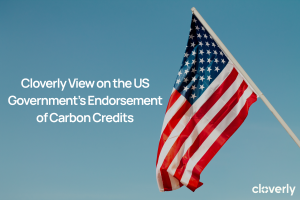The US Securities and Exchange Commission (SEC) has proposed new rules that would require publicly traded companies to disclose their climate-related risks and emissions. The rules are expected to be finalized in early 2024 and would likely go into effect in 2025 or 2026. As the deadline looms closer, the time for businesses to prepare is now. Read on to discover what your business can do now to comply with the SEC climate disclosure rule and maximize business advantages before the rule goes into effect.
“When markets have the information to accurately price the financial impacts of climate change, capital will shift towards businesses that prioritize climate resilience, transition, and sustainability.”
Mary Schapiro, TCFD Vice Chair and Former SEC Chair
Contact Cloverly today to harness the benefits of carbon credits while staying ahead of climate regulations.
Three core aspects of the proposed SEC climate disclosure rule
The SEC has proposed a new rule that will fundamentally change how companies report on climate-related matters. The new rule, rooted in enhancing transparency and accountability, revolves around three pivotal elements. Here’s an in-depth look at what they entail:
- Narrative disclosures: Companies will need to comprehensively disclose their governance structures, risk management protocols, and strategic approaches toward climate-related financial risks. Companies will also need to provide a detailed report of their emissions footprint aligned with the principles laid out by the Task Force on Climate-Related Financial Disclosures (TCFD). This ensures that stakeholders and investors get a clear, thorough understanding of how a company navigates and mitigates climate-related financial risks. According to SEC Chair Gary Gensler:
[The SEC climate disclosure rule] “… would provide investors with consistent, comparable, and decision-useful information for making their investment decisions, and it would provide consistent and clear reporting obligations for issuers.”
2. Mandatory independent attestation: The second crucial aspect is the requirement for an independent review of these disclosures. It’s important to note that this applies specifically to accelerated and large accelerated filersi. This provision is designed to be implemented gradually, with an initial phase focusing on Scope 1 and 2 emissions (Scope 3 will be required in subsequent years). Additionally, the level of assurance required will transition from “limited” to “reasonable” over time. This step is vital for ensuring the credibility and accuracy of the climate-related information provided by companies.
3. Integration into financial statements: Lastly, the proposed rule would necessitate the inclusion of a special note in financial statements. This note must detail the quantitative financial impacts of climate change on the company. It should cover both the risks from physical changes to the environment (physical risks) and risks associated with the transition to a lower-carbon economy (transition risks), along with how the company is addressing these challenges. Importantly, this requirement is only applicable if the financial impact is at least 1% of a specific line item in the financial statement, ensuring that the reported information is material and relevant.
The introduction of these rules marks a significant step toward integrating climate considerations into the fabric of financial reporting. It’s not just about compliance; it’s a strategic move toward more sustainable and transparent business practices. As these proposals take shape, companies must gear up for a new era of financial reporting – one that recognizes the profound impact of climate change on the business landscape.
The heart of the rule: Tracking & reducing GHG emissions
The proposed SEC climate disclosure rule requires disclosing Scope 1 and 2 emissions. Scope 3 emissions are also included if they are material, or if your company has set reduction targets that include Scope 3 emissions. Smaller Reporting Companies (SRC)i would be exempt from this requirement.
In light of the upcoming SEC rule, ESG teams are facing a number of challenges, including:
- Calculating emissions: Many companies do not currently track their emissions, which can be complex and time-consuming to calculate. Partnering with a reputable carbon accounting provider such as Sustain.Life or Net0—is a good way to build a system around measuring and tracking your emissions.
- Developing a carbon reduction strategy: Once a company has calculated its emissions, it needs to develop a decarbonization strategy. This strategy should be aligned with the company’s overall climate goals and objectives. Your carbon accounting partner can also help you build and implement near-term and long-term reduction strategies.
The role of carbon credits
- Buying carbon credits as part of your decarbonization strategy: Carbon credits are a way to neutralize GHG emissions by investing in projects that avoid or remove carbon dioxide from the atmosphere. This is an essential part of an effective decarbonization strategy for a number of reasons:
- Demonstrating climate leadership now: Most companies will not be able to cut emissions immediately, so investing in carbon credits today demonstrates environmental leadership while reduction actions are being implemented. (To learn how to make credible climate claims, watch the webinar).
- Addressing hard-to-abate and residual emissions: High-quality carbon credits can help companies neutralize hard-to-abate and residual emissions.
- Going beyond net zero: Some companies are taking steps to go beyond net zero and make positive climate contributions – for example by neutralizing past emissions by investing in high-quality carbon credits. This is another way to demonstrate climate leadership.
Ultimately, the heart of the SEC climate disclosure rule is asking companies to account for their GHG emissions, and set forth a thoughtful, achievable strategy to reduce them. However, reduction of emissions takes time—and the SEC climate disclosure rule is set to be finalized soon —, so investing in a portfolio of carbon credits now will help keep decarbonization efforts on track.
Any successful corporate decarbonization strategy must include reduction and credits to reach decarbonization targets, demonstrate real climate action to stakeholders, and prepare for disclosure.
Buy carbon credits now to reap the benefits
In a climate-conscious market, the strategic acquisition of carbon credits stands as a prudent move for businesses aiming to secure their environmental and economic future. By locking in offtakesii today, companies not only champion environmental stewardship but also ensure access to more affordable supply before future price surges. This proactive approach mitigates regulatory risks as governments intensify emissions crackdowns, positioning companies favorably as climate action leaders. This resonates with stakeholders like customers, investors, partners, and more who prioritize environmental responsibility, thereby bolstering a company’s reputation and financial health. Investing in carbon credits is not just an environmental decision—it’s a strategic business maneuver that aligns with both ecological and economic imperatives.
And the time to act is now. There are a number of reasons why companies should take action to buy carbon credits:
- The SEC rule is coming: Companies that are required to comply with the SEC rule will need to have a plan in place for disclosing their emissions and using carbon credits to neutralize immediate, residual, and past emissions. It is expected to be in place by early 2024, meaning that companies need to have a climate action plan in place now that can begin at the very start of 2024. And, as discussed earlier, credits are a critical part of any decarbonization strategy right now.
- Carbon credit prices are expected to rise: Demand for carbon credits is increasing rapidly, and supply is limited. With the new regulation, the demand will only increase. This means that carbon offset prices are expected to rise rapidly in the near future—and still remain a critical part of corporate decarbonization.
- Companies can invest in high-quality carbon credits to drive business results: In addition to climate benefits, buying high-quality carbon credits can help companies to improve their reputation, attract customers and investors, and reduce their regulatory risk. Moreover, they can point to their credits in the disclosures required, mitigating any risk of a lack of compliance.
The upcoming SEC rule has significant implications for companies—but there is infrastructure to make compliance both easy and beneficial. Companies should take action now to buy carbon credits in order to lock in offtake at current prices, secure supply, and stay on the cutting edge of technology and sustainability.
The best way to do this? Buy from a reliable source. Cloverly, for example, works with companies like HKS, American Express, Visa, and Redwood Logistics to help them reach their climate action goals.
How Cloverly can help
Cloverly presents a dynamic platform for companies looking to take tangible climate action through the purchase of carbon credits. This platform stands out by offering direct access to a handpicked selection of top-tier carbon removal projects, each thoroughly vetted by climate experts to ensure the highest quality and impact. With Cloverly, companies can navigate the complexities of carbon markets with ease thanks to spot, forward, and offtake agreements, bolstered by a robust end-to-end consultation service from an in-house team of climate scientists. Cloverly’s platform brings transparency to the forefront, providing comprehensive project insights, real-time availability, competitive pricing, and a seamless process for contracts, payments, and credit retirement. Companies are not only educated on the intricacies of carbon credits but are also supported with critical data at every step, ensuring informed decision-making and impactful climate action.
Contact us today to find out how to scale tangible climate action with high-quality carbon credits and stay ahead of regulatory changes.
i The SEC generally classifies filers by company size as follows: Large, accelerated filer: Initial public float of $700 million or more. Accelerated filer: Initial public float of $75-599 million. Non-accelerated filer and smaller reporting company (SRC): Initial public float of less than $75 million.
ii An offtake is a multi-year, pre-purchase agreement to buy carbon credits.





